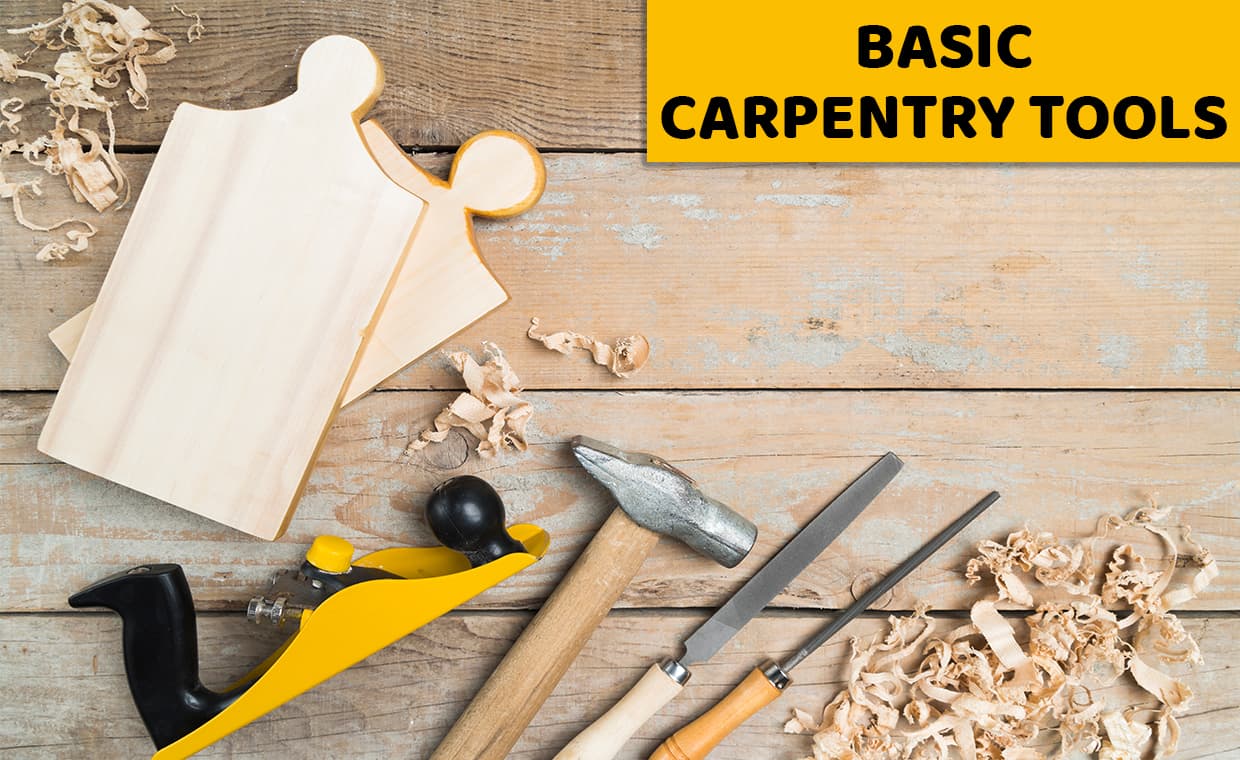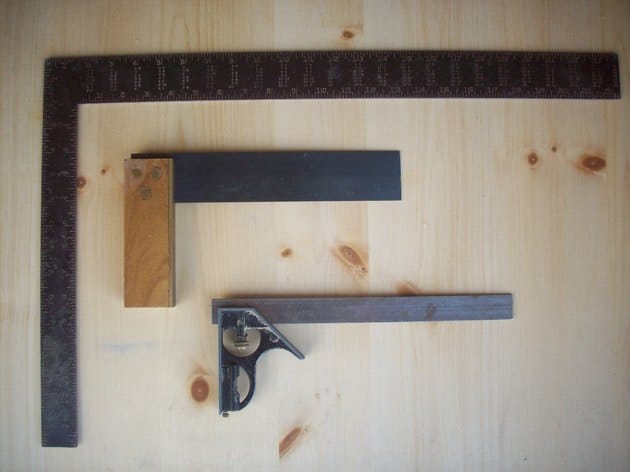
One of the most traditional roles or trades in the construction industry is carpentry. This list not only shows you the basic carpentry tools for DIY that you need but also provides a brief description of basic carpentry tools for DIY that the carpenters use daily.

As with every trade, carpenters might require many tools to perform their work but this list summarizes the basic DIY tools ones or the most used tools in a carpentry work. In this article, we have also listed some carpentry tools that you can DIY for your home, minor repairs.
Carpentry Tools
01. Tape Measures

Measure Tape
Retractable tape measures are among the most important items needed for any woodworking. Choose a tape with large numbers that are easy to read. Some have decimal equivalents or other pertinent information printed on one side for more detailed work. Most carpenters use two tapes: one 12 feet long and easy to handle, and one 25 feet long for big layouts. In your house, this is useful when you are going to buy a new furniture. You might to measure the space in your room for your suitable furniture.
02. Claw Hammer

Claw Hammer
The most basic tool in every carpentry work is a claw hammer. The claw on one side of the head should be well counterbalanced by the finished head, which should be somewhat rounded. The other kind of head is the waffle-head. Most commonly used in construction, it leaves a distinctive waffle mark on the wood when you drive the nail. This, of course, is not the proper nail for woodworking.

Waffle Face vs Smooth Face Hammer
A poorly-balanced claw hammer will get twisted in your hand, making it difficult to drive nails properly. You normally grip a claw hammer with your hand at the back of the grip, letting the weight of the head do most of the work. All you have to do is to direct the driving surface toward the right nail, sparing the ones on your hand.
The most commonly purchased claw hammer is the 20 oz. (566.99gram) size. It’s heavy enough to easily drive nails but easily manipulated when pulling nails. While wooden handles are picturesque, they may not stand up to the strain if you have to pull a lot of nails. Hammers with a steel handle, or even fiberglass, will be stronger.
However, these won’t absorb the vibrations from driving nails the way a hickory handle will. You’ll also need to make sure the fiberglass and metal handles have a rubberized grip for control and comfort. If you’re going to be driving a lot of nails, the wooden handled hammer will be better for reducing stress on your hand, and wrist, too.
The other side of the head curves down and splits in the middle forming a “V” shape. This part is the claw of the hammer and is most commonly used for extracting nails from wood. The rounded end of the claw, in combination with the handle, is used to gain leverage when extracting a nail.
In your house, you can use this hammer for nailing wooden products for repairs, hanging arts on walls, dismantle small works, fencing, etc.
03. Jack Plane

Jack Plane
A Jack Hand plane is a middle size “bench plane” (i.e. planes that are used so often that they are usually on your workbench). If you’re on a budget a jack plane can temporarily be used in place of other planes that perform specialized functions:
(i) rough stock removal (if you buy a second iron/blade and shape it with a curved “camber”), (ii) jointing board edges (as long as they aren’t too long), and (iii) smoothing the boards.
04. Hand Saw

Hand Saw
The irreplaceable and always reliable tool that offers many variations but all serve a common purpose. The hand saw is the one preferred by traditional carpenters as they can control the cut while producing a great finish. Because this tool has many variations, the hand saw is always a useful tool to have with you.
There is traditional saw, hacksaw, coping saw, and rip saw among others. Hand saws are not a replacement for power saws, but being the most simplistic one, it is helpful, not optional, to have. If you can, having a power saw is a great idea, and a cordless one is even better.
In woodworking and carpentry, hand saws, also known as “panel saws”, are used to cut pieces of wood into different shapes. This is usually done in order to join the pieces together like in making of fence on any other repair works.
05. The Chisel

The Chisel
A good chisel made of alloyed steel is needed to complete clean cuts. Chisels are available in different sizes starting at 1/4 inch (6mm) to 2 inches (51mm) long. Chisels are used by carpenters and woodworkers for chipping out wood for door hinges and other fine woodworking jobs. There are also corner chisels that act like a hole punch, removing a section of wood with one hammer blow. Remember to keep the edges sharp and oiled so the chisel can last longer.
Wood handles are recommended, capped with metal, so they can withstand the constant hammering and can last longer. Chisels are great for positioning prying deck boards before attaching them to the framing structure. Chisel tools are used for cutting or carving hard materials such as metal, stone or wood.
06. The Level

The Level
Every woodworker needs a couple of levels. You probably won’t need one of the 6-foot levels used in construction, but 48” is a good length for many of the woodworking projects. Usually, you’ll also need an 8” level too, usually known as a torpedo level. You check the level and plum of your construction. Level means horizontal, and plumb is vertical. A spirit level, bubble level or simply a level is an instrument designed to indicate whether a surface is horizontal (level) or vertical (plumb).
Most quality levels are made of either brass-edged wood or of metal. There will be a bubble reading for level, and another one for plumb. When the bubble is exactly between the lines, you have a level or plumb surface. You can also get string levels and laser levels, but the woodworker will use these types of levels the most often.
07. The Screwdriver

The Screwdriver
Screwdrivers are another must-have in the woodworker’s set of hand tools. Not only will you need Phillips and slot, or flathead screwdrivers, you’ll need star drivers and Torx drivers, too. A quality construction is vital to a good set of screwdrivers. So many of them are made out of soft metal, and the first time you put any “oomph” behind them, they strip out, becoming absolutely useless.
You’ll need a long screwdriver with a square blade that is very heavy duty. This gives you a lot of torque. You’ll also need a small and medium slot screwdriver. For working on cabinets or tight places in woodworking, you’ll need a screwdriver with a thin shank so that you can reach screws that are inside of deep holes. This is accomplished with a cabinet screwdriver. Get a couple of medium Phillips head screwdrivers, and a stubby one too, for those tight places. You may also want a ratcheting screwdriver.
08. The Nail Set

Nail Set
The next hand tool every woodworker should have is a nail set. In fact, you should have several sizes. They look like awls, and you use them to drive nail heads into the wood so they are flush or right below the surface. This allows you to fill the holes and prepare for staining or painting. The nail setter will usually have either a convex or concave surface to grip the nail better and keep it from sliding off and marring the wood.Nails are most commonly used to fasten pieces of wood together in DIY carpentry works.
09. The Carpenter’s Square

Carpenter’s Square
A carpenter’s square is still one of those tools that no matter how advanced our technology is, we will still need the square to make some cuts. The preferred size one is the 6-inch model, easy to carry and use. It is great when used with a table saw and can even help with some angles as well.
When buying one, make sure to choose a metal one as plastic can lose its shape and might affect your accuracy in measurements. Its uses extend into framing and laying rafters and stairs. It can also be used as a straight-edge, finding and establishing right angles and marking cut-off work on wide stock.
10. Quick Clamps

Quick Clamps
Clamps are very useful in the carpentry industry. They are used to secure and grip pieces of wood and lumber so your hands can be free to saw, cut, or perform other woodworking tasks more efficiently. They are available in many sizes, designs, models, and styles so you can attach them to the different working surfaces. Clamps, especially quick clamps, are very useful when making 45- and 90-degree cuts.
11. Cat’s Paw

Cat’s Paw
A cat’s paw is used to remove stubborn nails when claw hammers fail. It’s pounded with a hammer to undercut and pry out the nail. Cat’s paws are stiff and tough enough to use as a pry bar, and come in small sizes.
12. Utility Knife

The Utility Knife
A good utility knife is another asset for the woodworker. There are many different kinds, but the kind that uses disposable blades is the most common. The blade retracts into the grip for safety. The woodworker will use the utility knife when cleaning out mortise joints or to scribe wood, as well as many other uses.
13. Pencil

Pencil
A carpenter always needs a pencil to mark where the next cut will be. There is mechanical carpenter’s pencil that will never need to be sharpened again. This type of pencil looks like a utility knife to make a sharp clear line. It is somewhat expensive but you will love it and it will be easier to carry and use.
Pencils or in some instances chalk lines are always useful, cheap, and will help you when laying out framing or making cuts.Pencils are also used by anyone in your house, because they are suitable for marking on rough surfaces, such as concrete or stone.
14. Work Bench

Work Bench
A saw horse or workbench is a very practical and convenient tool. A saw horse is a carpenter’s best friend, helping you resting the piece of wood while you can work or cut other areas of it. Light weight and portable saw horses are used very frequently in carpentry during framing or door installation, allowing you to make precise cuts even when you are working all alone. The most sophisticated models are equipped with clamps and adjustable surfaces so you can move it around and fit almost any type of wood. Aworkbench is a table used by woodworkers to hold workpieces while they are worked by other tools.
Above listed were the tools which are user-friendly and can be widely used for carpentry works without any technical help. I hope the content in this article regarding carpentry tools is sufficient enough for any person to use it in DIY manner. If you think that some basic tools for carpentryhas been missed out, you can share comments in this comment box below. Stay tuned for article on Advanced Tools for Carpentry.
Also Read:
Plywood vs Blockboard: How to Make the Right Choice
Solid (Natural) Wood vs Plywood vs Blockboard vs HDF vs MDF vs Particle
Board: Make the Right Choice of Engineered Wood
Image Courtesy: Image1, Image 2, Image 3, Image 4, Image 5, Image 6, Image 7, Image 8, Image 9 ,Image 10, Image 11, Image 12, Image 13, Image 14 – coptool , Image 15, Image 16































